Heartburn
Struggling with heartburn? Here’s what you need to know to find relief.
ALL TEST ARE ACCREDITED & REGULATED BY



What is heartburn?
Heartburn is a burning pain in your chest. This pain is caused by stomach acid rising from your stomach into your oesophagus (the pipe that takes food from your mouth to your stomach).
This can cause:
- Burning pain in the middle of your chest
- Pain which is worse when you bend over or lie down
- Burning pain that radiates into your back
By learning more about the causes of, tests for, and treatment for heartburn, you can understand it better and make informed decisions to get back on track.

Why does heartburn happen?
There are several possible causes of heartburn, and it’s important to find out what’s causing yours.
Here are the main causes of heartburn:
Gastroesophageal reflux disease (GORD)
Hiatus hernia, when part of your stomach moves up into your chest
Surgery you’ve had in the past (especially bariatric surgery)
Certain foods and drinks, such as alcohol, coffee, chocolate, and fatty or spicy foods
Being overweight
Smoking
Pregnancy
Stress or anxiety
Medication, such as anti-inflammatory painkillers
Overgrowth of bacteria in your small intestine (this is called SIBO)

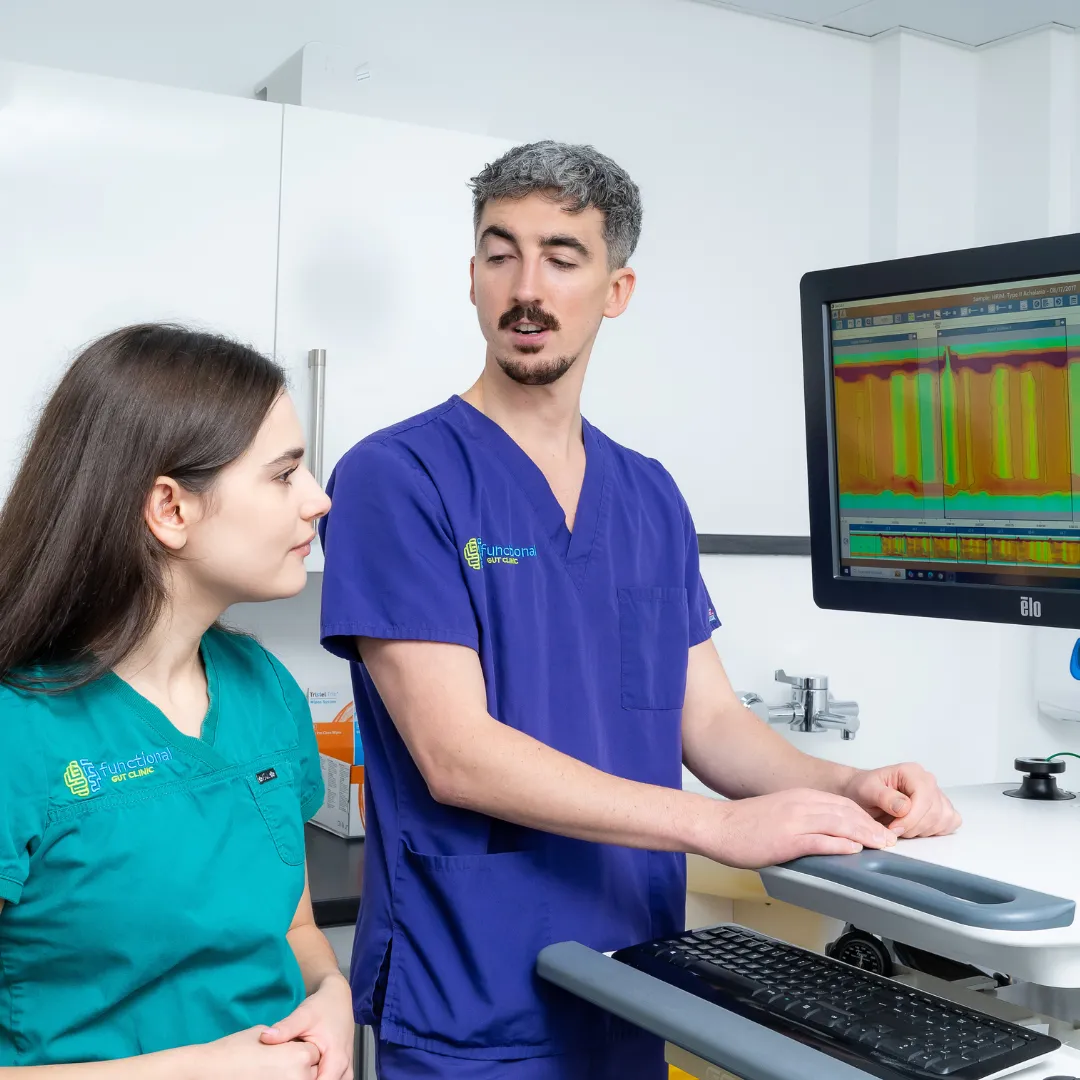
Diagnosing heartburn
Diagnostic testing allows us to pinpoint the exact cause so we can recommend the right solution.
Oesophageal manometry, 24-hour pH, malabsorption breath tests, SIBO & gastric emptying
At the Functional Gut Clinic, we use the following highly accurate and trusted diagnostic tools, to identify the underlying cause of your heartburn:
Oesophageal manometry – which measures the function of your oesophagus (food pipe)
24-hour pH impedance monitoring – which looks at whether you have any reflux
Carbohydrate malabsorption breath test – which finds out if you have certain food intolerances (lactose or fructose)
Small intestinal bacterial overgrowth (SIBO) breath test – which finds out if you have an overgrowth of bacteria in your small intestine (called SIBO)
Gastric emptying test – which measures how quickly food leaves your stomach
Learn more about heartburn

What is Bloating and Distention
What Is Bloating and Distention?
For many patients with irritable bowel syndrome (IBS) and functional gut disorders, one of the most bothersome symptoms is bloating, a sensation of increased abdominal pressure.
Around 50% of patients with bloating also experience distension, an increase in abdominal girth of up to 10cm. Distension can be particularly intrusive, causing many sufferers to avoid wearing certain clothes and not attend social events due to their appearance.
What are the causes of bloating?
The causes of bloating and distension are often multifactorial, meaning individuals may have one or more underlying causes for their symptoms. Although overlapping, research has shown bloating and distension to have differences in their pathophysiology. Hypersensitivity in the abdomen plays a major role in bloating and has a great association with diarrhoea-predominant IBS (IBS-D). Meanwhile, distension is more commonly associated with constipation-predominant IBS (IBS-C), often caused by slow intestinal transit.
Individuals with IBS have been shown to handle gas differently than those without IBS. In one study, IBS patients retained significantly more gas in their abdomen compared to healthy volunteers. This gas retention was linked to increased symptoms of bloating and distension.
Those who struggle with bowel movements, such as people with constipation, also tend to experience more bloating and distension. This is likely due to difficulty clearing gas and stool from the gut, leading to a buildup that causes discomfort.
When the volume in the intestines increases, due to gas or food, the body adjusts through what’s known as the accommodation reflex. In healthy individuals, this reflux involves the internal oblique muscles contracting and the diaphragm relaxing, helping to manage the pressure and prevent visible bloating. However, in people who experience bloating and distension, this response appears to work in reverse. Instead of adjusting normally, their diaphragm contracts and the internal oblique muscles relax, which leads to greater abdominal distension compared to healthy individuals.
Bloating is also seen in patients suffering from small intestinal bacterial overgrowth (SIBO). In healthy individuals, there is a much smaller concentration of bacteria in the small bowel compared to the colon. When gut bacteria over-proliferate the small bowel, they can begin to ferment ingested nutrients before our body absorbs them. The by-products of this fermentation (gases, water and short chain fatty acids) can then lead to symptoms of bloating, diarrhoea and abdominal pain.
Carbohydrate malabsorption can also cause bloating, the most commonly described being lactose malabsorption (hypolactasia). Lactose is the sugar naturally found in dairy products, it is a disaccharide meaning it is made up of two simple sugars (monosaccharides), glucose and galactose. Hypolactasia is a condition where the enzyme lactase becomes depleted in the small bowel. Lactase is required to break down lactose into the two simple sugars before they can be absorbed. If lactase is depleted this process will be impaired leading to fermentation of lactose in the colon, causing bloating amongst other abdominal symptoms. Hypolactasia has a higher prevalence Eastern, African, South American populations compared to European populations.
Even in healthy individuals it is normal for some carbohydrates to enter the colon where they are fermented. These sugars are known as Fermentable Oligosaccharides, Disaccharides, Monosaccharides, and Polyols (FODMAPs). Where an imbalance of colonic bacteria occurs (dysbiosis), as seen in patients with an irritable bowel, there may be altered fermentation of these carbohydrates in the proximal colon. The production of increased short chain fatty acids as a by-product of colonic fermentation may cause changes to the pH of the gut and altered gut motility. These changes to the environment and motility of the gut in addition to the gases produced as by-product of fermentation may ultimately contribute to bloating and distension.
How can bloating and distension be treated?
Understandably, these symptoms can significantly affect quality of life, so an effective treatment could make a big difference to many IBS patients. Due to the diversity of causes of bloating and distension, treatment will be specific to the underlying causes of bloating. However, a range of methods have been shown to alleviate symptoms for some patients, including dietary modification, medications and physical therapies.
How can SIBO be detected and treated?
A simple breath test may detect if SIBO is responsible for bloating. If positive, specific antibiotic regimes can decrease the bacterial count in the small bowel. By reducing levels of small intestinal bacteria, premature fermentation of ingested foods is reduced, thus alleviating symptoms of bloating.
Can probiotics help to reduce bloating and distension?
If SIBO is not the cause of symptoms other therapies may be considered. As gut microbiota may differ in IBS to those in healthy individuals, alteration of the microbiota with probiotics is a potential target for alleviation of bloating and distension. One study demonstrated that the daily intake of a probiotic yoghurt (Bifidobacterium lactis) alleviated distension in patients with IBS-C through acceleration of intestinal transit. In another study, a combination probiotic (VSL#3) was shown to reduce symptoms of bloating and slowed colonic transit in a proportion of patients.
Despite positive results from several studies, further research into different types of probiotics (species, mixtures, strains), optimum dosage and treatment length are required to better understand the role of probiotics and their effect on bloating and distension. When trialling probiotics, individuals should only use one probiotic at a time allowing them to evaluate the effect of the probiotic on their symptoms more accurately. Individuals should follow manufacturers/healthcare professionals’ dosage instructions and consume for at least 4 weeks.
Can a change in diet help to reduce bloating?
Introduction of a low FODMAP diet may help relieve symptoms by removing these highly fermentable sugars from the diet, thus reducing fermentation. These troublesome sugars are found in foods such as onions, garlic, dairy and some fruits. A low FODMAP diet can be quite restrictive and therefore should be undertaken with the guidance of a registered dietician. The dietician will be able to guide patients on which foods they need to initially restrict, as well as manage the reintroduction of specific foods to make sure there are no shortfalls in the patients’ nutritional intake.
Breath tests can also be carried out to assess whether individuals are malabsorbing specific sugars such as lactose and fructose. By finding out if certain sugars are being malabsorbed it is possible to tailor diets to reduce bloating caused by fermentation of these specific sugars.
What about Faecal Microbiota Transplantation (FMT) and what is it?
There is increasing public and media interest in the topic of FMT and its potential uses. FMT is the process of collecting faeces from a healthy donor, separating the gut bacteria (microbiota) from other faecal matter and transplanting the microbiota into another individual with a disease or disorder relating to the microbiota. The aim of this process is to repopulate the gut of the diseased individual with the microbiota of the healthy individual and thus treating the underlying cause of the disease.
FMT is the most effective treatment for recurrent Clostridium Difficile and research is showing promise in other conditions such as ulcerative colitis. A great deal more research is needed to establish the effectiveness and safety of FMT in other conditions including IBS and this will certainly be a hot topic in coming years.
Are there any medications which can help alleviate bloating and distension?
Antidepressants at a relatively low dose can be used to target bloating. Studies have shown that citalopram can significantly reduce symptoms of bloating through its effect on improving bowel motility and regularity. Other antidepressants such as amitriptyline are also known to improve stool consistency and reduce hypersensitivity of the gut, thus reducing the sensation of bloating.
Other medications have a more specific effect on the bowel. The drug linaclotide increases transit time and reduces visceral hypersensitivity via activation of the enzyme guanylate cyclase C and has been shown to reduce the symptom of bloating and in patients with IBS-C.
The medication ebastine, a antihistamine has been shown to relieve bloating and distension among other IBS symptoms in a recent clinical trial. It works by desensitising the TRPV1 pain receptor, where typically histamine and its metabolites bind, contributing to visceral hypersensitivity.
Are there any physical therapies that can be used to reduce distension?
Biofeedback is a clinical tool used by clinicians and physiotherapists to reduce distension. One study demonstrated the effectiveness of biofeedback by comparing participants with distension to healthy volunteers. Through electrodes attached to the skin, respiratory targeted biofeedback helped to reduce the activity of the diaphragm (by 18% ± 4%) and intercostal muscles (by 19% ± 2%) and increased the activation of the internal oblique muscles (by 52% ± 13%). An average reduction in abdominal girth of 25mm was seen in these patients following this biofeedback technique.
Biofeedback can be utilised in patients with defecatory disorders to improve evacuation techniques, thus reducing bloating and distension. In order to pass stool, it is important to relax the muscles in the back passage. Some individuals inadvertently contract the muscles in the back passage, which acts as a barrier to passing stools, known as dyssynergia. Pelvic floor targeted biofeedback conducted by a trained physiologist or physiotherapist can help individuals to visualise their bad toileting technique and correct it.
Although there is a large range of treatment options targeting the various causes of bloating and distention, they will not all work for everyone. It is important to identify the underlying mechanisms and contributing factors behind the symptoms on a case-by-case basis to select the most effective treatment for each patient.
Think you could benefit from some biofeedback therapy to target your troublesome GI symptoms? Contact us today to see how we can help you.
Heartburn is a burning pain in your chest.
Heartburn is often experienced after eating and can last anywhere from a few minutes to several hours. The stomach releases more acid after eating certain foods, including spicy dishes, fatty foods, citrus fruits, tomato-based products, garlic, and caffeinated drinks. The more acid that is produced, the greater the risk of heartburn.
Other factors include obesity, smoking, stress, pregnancy, and eating too close to bedtime.
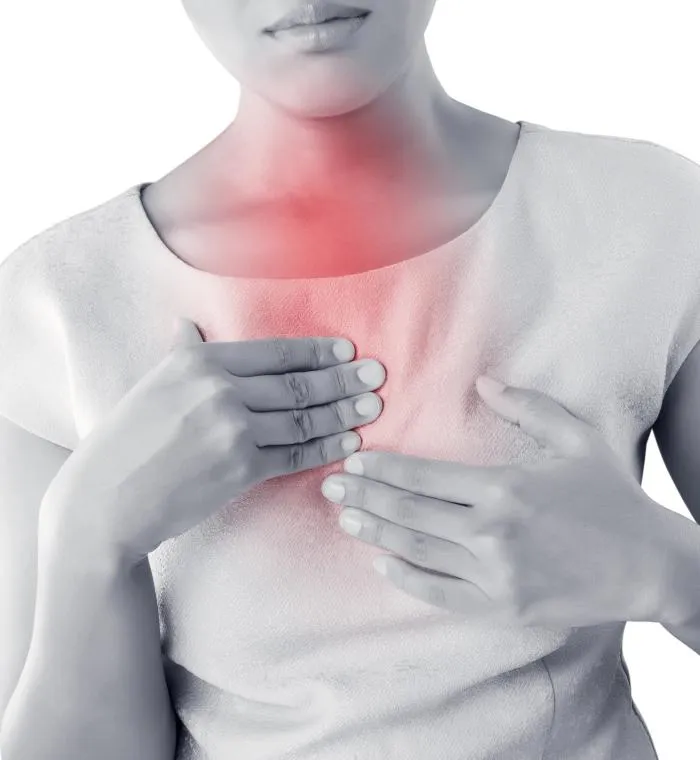


What are the symptoms of heartburn?
Heartburn primarily causes an uncomfortable or burning sensation in the middle of your chest. You may also experience:
A burning sensation in your throat
A strong acidic or sour taste in your mouth
Difficulty swallowing (dysphagia)
A feeling of pressure or pain behind your breastbone
Repeated coughing
Hoarse voice
In addition to these symptoms, the pain from the acid can get worse when lying down or bending over. This is because the acid flows out of the stomach and into the oesophagus. Whenever you lie down, you increase the risk of heartburn-related symptoms.
Constant heartburn is a sign of a severe underlying condition. Most people experience heartburn in episodic attacks – usually after consuming certain foods. If the heartburn is persistent, it’s crucial to speak to a medical professional. You can also consider organising a test via The Functional Gut Clinic (see below).
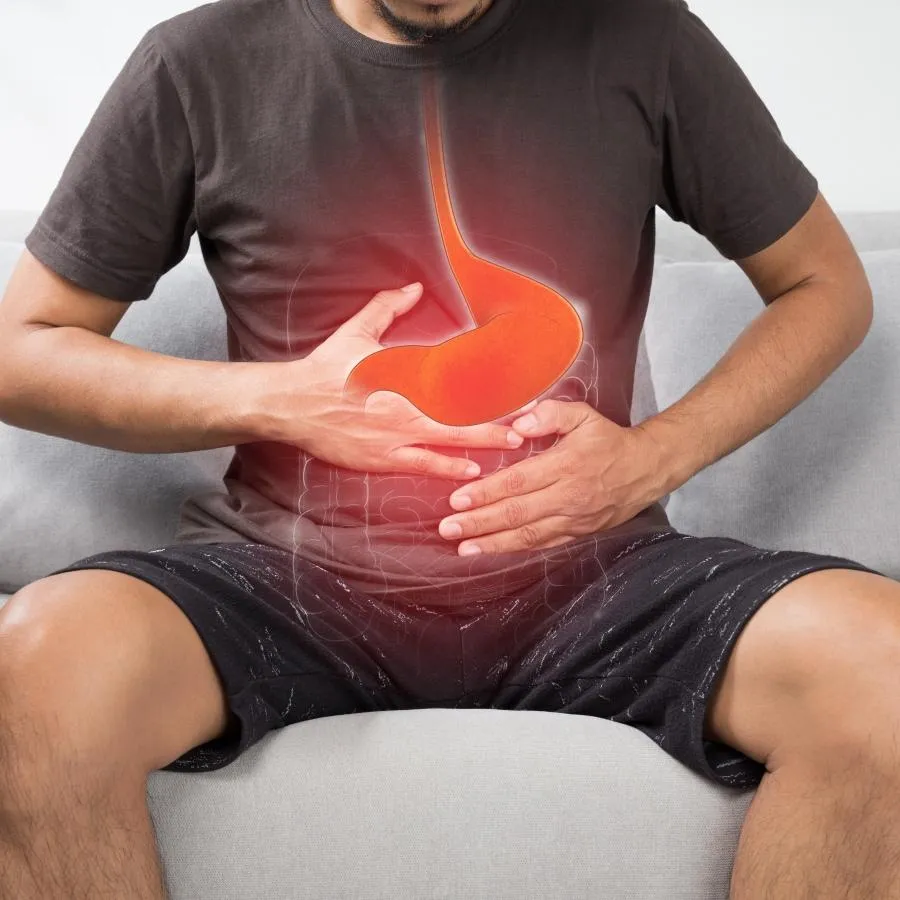
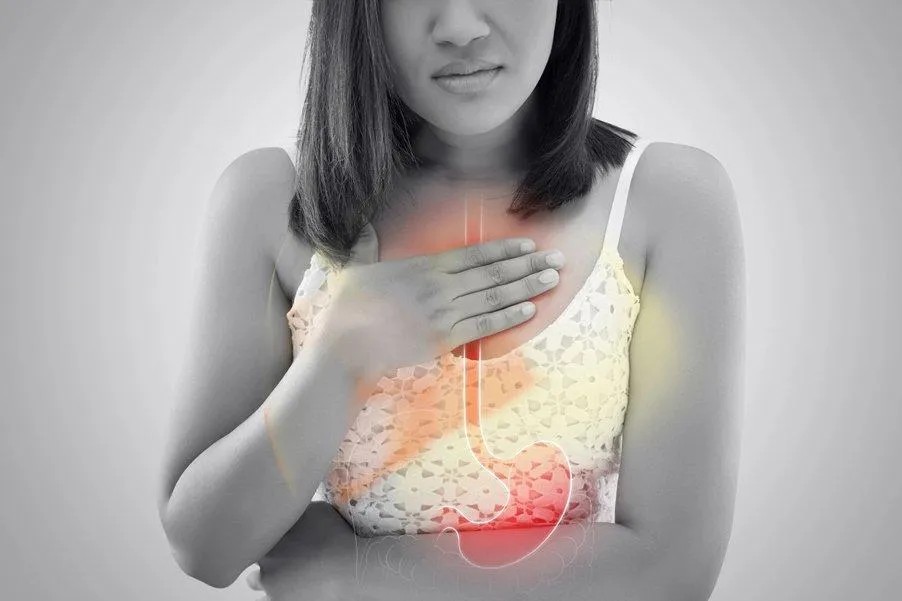
What causes heartburn?
Heartburn occurs when the contents of the stomach enter the oesophagus (the food pipe connecting your stomach to your throat). Usually, the stomach contents are prevented from going back into the oesophagus by a juncture called the lower oesophageal sphincter. However, in some people, this sphincter doesn’t function properly.
Heartburn is a symptom of gastroesophageal reflux disease (GORD). GORD simply refers to the backflow of acid from the stomach into the oesophagus. GORD is the condition; heartburn is the symptom.

Several factors increase the risk of heartburn. The causes of heartburn and GORD either increase acid production within the stomach or affect the functioning of the lower oesophageal sphincter. These include:
Hiatal hernia. A hiatus hernia involves a part of your upper stomach penetrating through the diaphragm (the layer of muscle separating your chest from your stomach). This usually occurs due to a weakness or tear.
Pregnancy. If you become pregnant, the increased pressure during the third trimester (and sometimes earlier) forces the stomach contents backwards, causing heartburn.
Surgery. Previous surgery, especially bariatric surgery, increases the risk of not only heartburn but also a hiatus hernia.
Smoking. Smoking is closely linked to heartburn and GORD. People who quit smoking notice a significant reduction in heartburn symptoms.
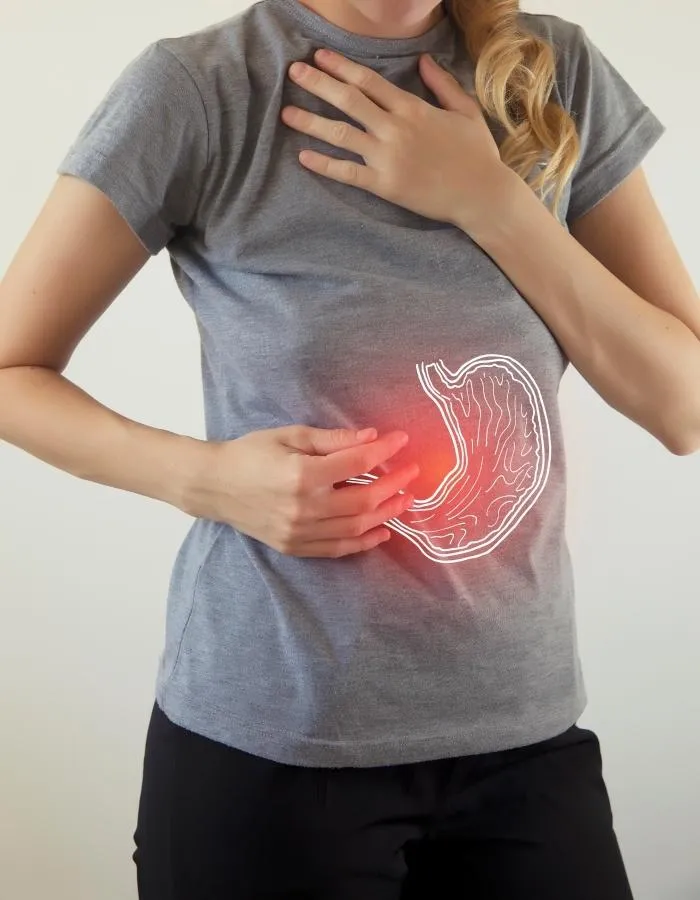
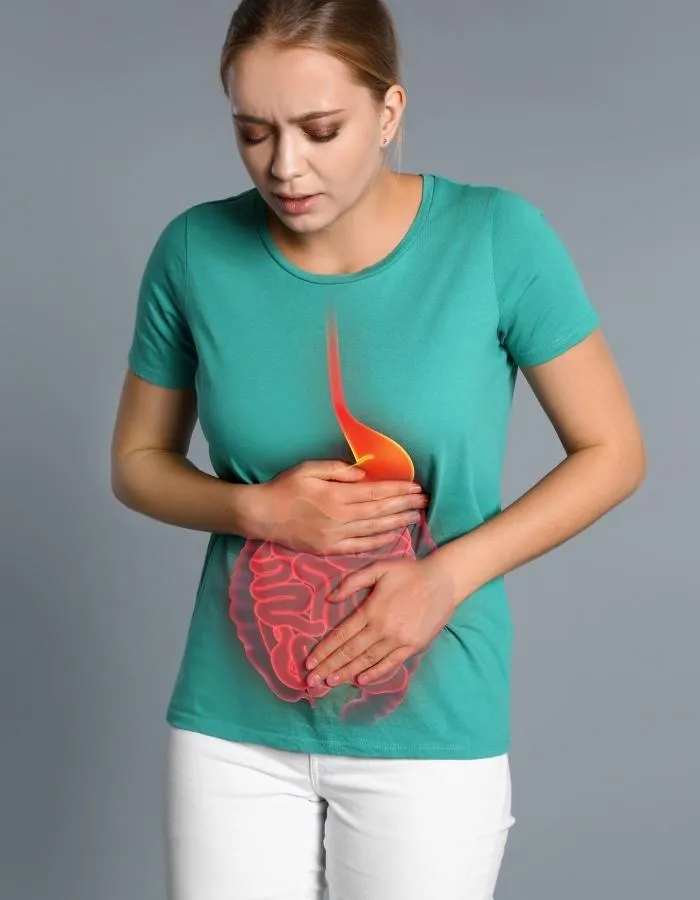
Overweight or obesity. Being overweight or obese is a major risk factor for GORD. This is likely due to the increased pressure in the stomach alongside a diet high in fatty, processed foods.
Medications. Certain medications, such as anti-inflammatory painkillers (e.g., ibuprofen or aspirin), sedatives, and blood pressure medications, can increase your risk of heartburn.
Stress or anxiety. An increase in stress or anxiety can increase acid production in some people, leading to heartburn. It’s often accompanied by another factor.
Small intestine bacterial overgrowth (SIBO). Excessive bacterial growth in the small intestine leads to increased abdominal pressure and subsequent acid reflux, which can cause heartburn. Managing SIBO often reduces these symptoms.
Foods to avoid
Acid production is a normal part of the stomach’s function. The acid helps digest food. Certain foods require more acid to digest, triggering an increased production in the stomach.
For most people, this isn’t an issue as the acid flows into the small intestine. However, if you struggle with heartburn and GORD, then it’s sensible to limit or avoid certain foods. These include:
Citrus fruits (like oranges and grapefruits)
Tomatoes and tomato-based products
Spicy foods
Garlic and onions
Chocolate
Mint
Fatty or fried foods
Caffeinated beverages (such as coffee and tea)
Carbonated drinks
Alcohol
It’s not just the food. Eating an excessively large meal, wearing tight clothes, and lying down soon after eating can increase the risk of heartburn. If you’re experiencing persistent heartburn, it’s often linked to diet rather than another factor.

Is heartburn the same as GORD?
No. Heartburn specifically refers to the burning sensation in the chest. GORD is the underlying condition involving the backflow of acid. Heartburn is a symptom of GORD. Acid reflux is sometimes used as shorthand for GORD – however, not every attack of acid reflux is an example of GORD.
Acid reflux refers to any episode of acid backflowing into the oesophagus. If the episodes occur two or more times a week, it is diagnostic for GORD. Most people experience acid reflux episodes occasionally. This can increase in frequency as acid reflux progresses to GORD. You should speak to a doctor if you notice this change.

Does acid reflux always cause heartburn?
Heartburn is always caused by the backflow of acid into the oesophagus. Several other conditions can create a similar sensation. For example:
Oesophageal ulcers. Ulcers occur due to erosion of the oesophageal lining. Often associated with acid reflux or overusing anti-inflammatory medications.
Oesophagitis. Severe inflammation of the oesophagus is closely linked to GORD. However, it can also be caused by medications and infections. An allergic condition known as eosinophilic oesophagitis can also cause heartburn.
Functional heartburn. Unlike the other conditions, this isn’t a problem with your oesophagus or stomach. It’s caused by a disorder of the gut-brain connection. It involves the same heartburn symptoms but without any signs of acid reflux or inflammation. It’s connected to overactive nerves.

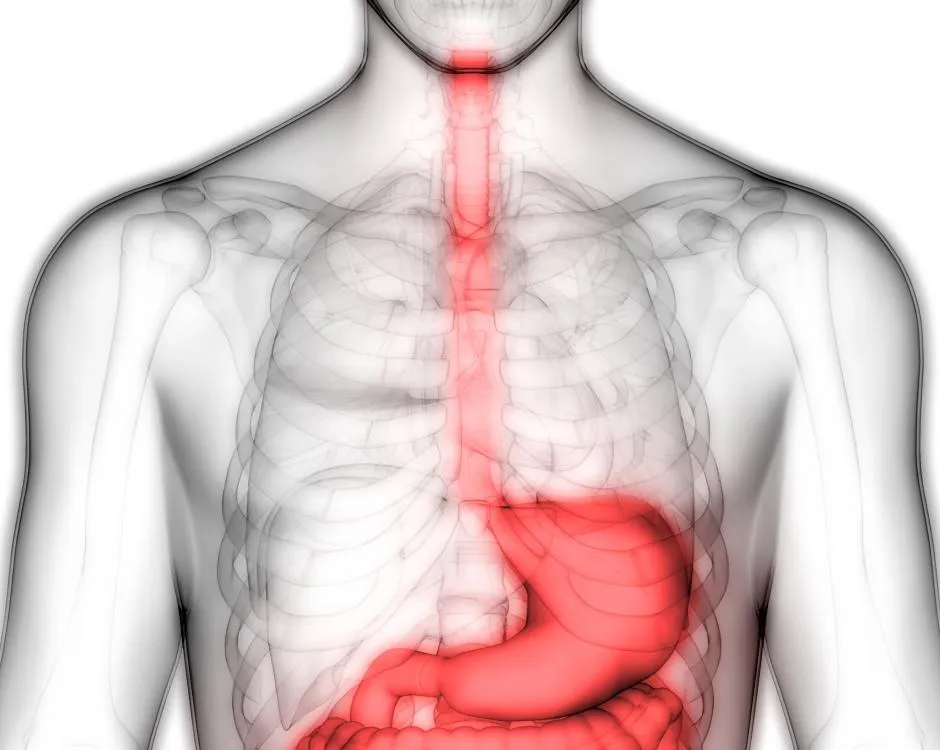
How long does heartburn last?
Heartburn is not a permanent condition. It lasts as long as the acid is present to irritate the oesophagus and throat. Most people experience heartburn and GORD for between a few minutes to several hours. The timespan often depends on the underlying cause. For example, if your heartburn is due to your diet, it might go away within a few minutes. In contrast, if you have a hiatus hernia, the heartburn might persist for much longer, even after standing up.
Constant heartburn is a rare symptom. It’s a concerning sign, as the acid can continue to damage your oesophagus. If you’re constantly feeling heartburn (or using lots of antacids), then it’s critical to speak to a doctor.
Is heartburn serious?
Most cases of heartburn aren’t serious. It’s common to experience heartburn after a large meal or eating certain foods. However, if the heartburn becomes repeated or constant, it can cause long-term damage. Usually, the damage caused by acid reflux heals like any injury. If it happens regularly, then the oesophagus lining can become permanently injured.
Potential long-term complications include:
Oesophageal strictures. The lining of the oesophagus becomes replaced with scar tissue due to repeated inflammation. This scar tissue causes a narrowing of the oesophagus (stricture), which prevents food from getting through.
Intestinal metaplasia. The tissue lining of the oesophagus undergoes a change to look more like the lining of your intestines, protecting it from damage. It is called Barrett’s oesophagus and is a precancerous condition.
Oesophageal cancer. Cancer is a rare complication of GORD and heartburn. It occurs due to persistent inflammation and cellular changes. The longer your heartburn persists, the greater the risk of cancer.
Heartburn and GORD can also indicate problems in your stomach. For example, excess acid production can lead to gastritis (stomach inflammation) and stomach ulcers. It may also aggravate preexisting conditions such as asthma.
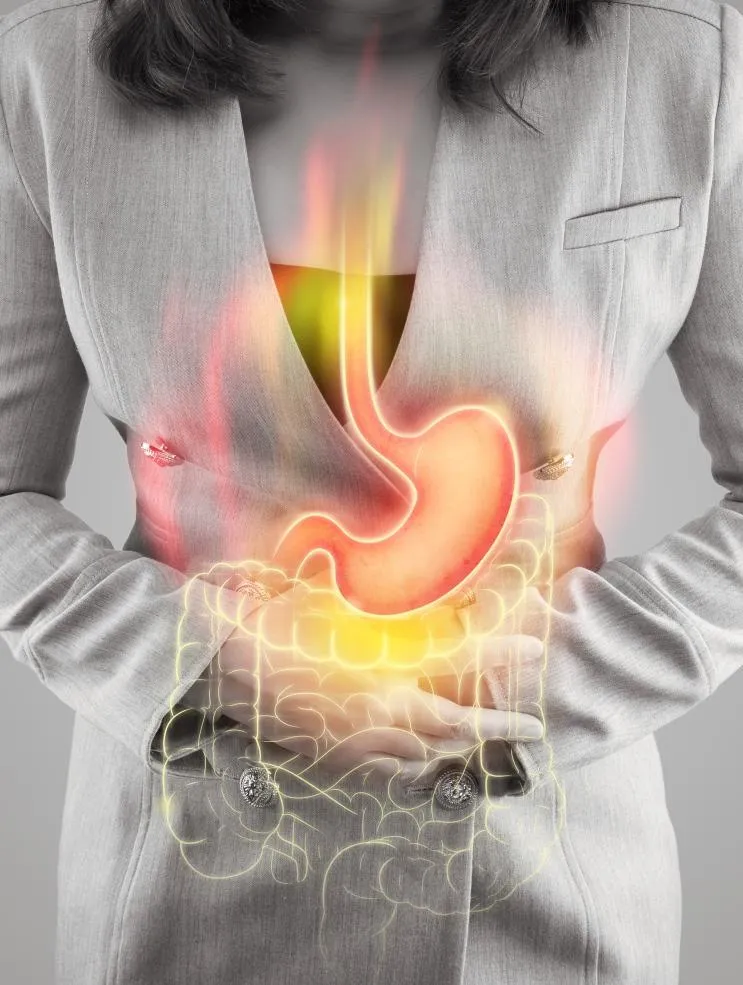
How do we diagnose the causes of heartburn?
The following tests may be used to diagnose what is causing your heartburn:
Oesophageal manometry – which measures the function of your oesophagus (food pipe)
24-hour pH impedance monitoring – which looks at whether you have any reflux
Carbohydrate malabsorption breath test – which finds out if you have certain food intolerances (lactose or fructose)
Small intestinal bacterial overgrowth (SIBO) breath test – which finds out if you have an overgrowth of bacteria in your small intestine (called SIBO)
Gastric emptying test – which measures how quickly food leaves your stomach
The following tests may be used to diagnose what is causing your heartburn:
Oesophageal manometry – which measures the function of your oesophagus (food pipe)
24-hour pH impedance monitoring – which looks at whether you have any reflux
Carbohydrate malabsorption breath test – which finds out if you have certain food intolerances (lactose or fructose)
Small intestinal bacterial overgrowth (SIBO) breath test – which finds out if you have an overgrowth of bacteria in your small intestine (called SIBO)
Gastric emptying test – which measures how quickly food leaves your stomach

Heartburn treatment
Lifestyle changes
Most people who experience occasional heartburn symptoms can benefit from lifestyle changes. This involves limiting exposure to potential triggers. You might want to try:
Avoiding trigger foods, such as fatty foods or caffeinated beverages
Eating smaller meals
Avoiding tight clothing
Avoiding lying down immediately after eating
Quitting smoking and alcohol consumption.
Often, people find that small changes to their diet can stop or reduce episodes of heartburn. If the heartburn continues, it’s usually a sign that something else is going on. It’s crucial to get to the bottom of your symptoms; otherwise, they will persist.

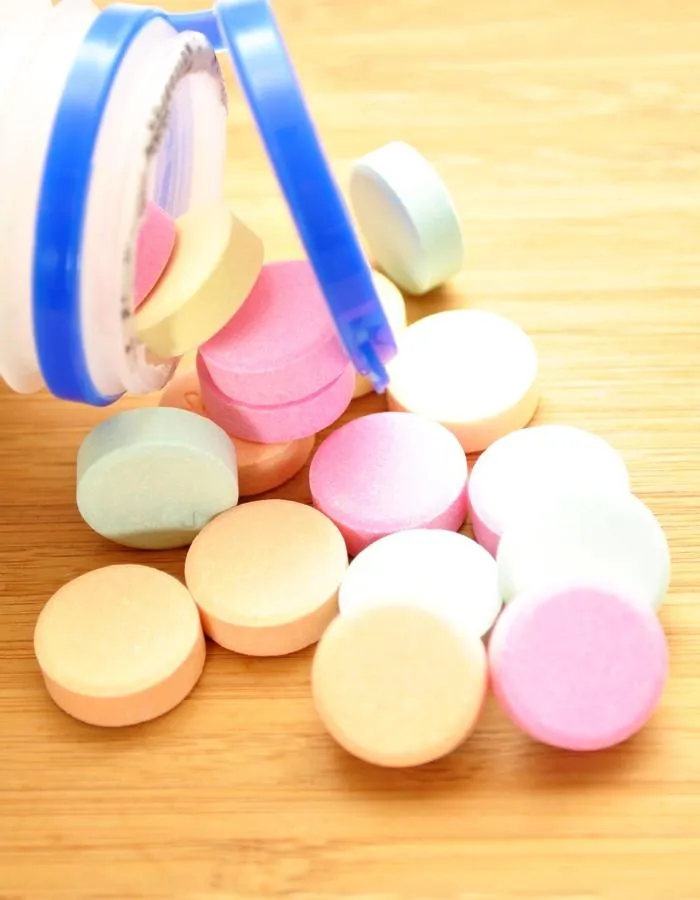

Medication
As heartburn is caused by acid, neutralising this acid relieves symptoms. The primary treatment for heartburn is an over-the-counter (OTC) antacid, such as Gaviscon or Alka-Seltzer. These medications provide immediate relief from your symptoms – perfect for tackling a sudden acid reflux attack. If you experience constant heartburn, it’s sensible to carry antacids with you. However, excessive use of antacids can cause other problems.
Your doctor may prescribe medications that prevent acid production. This includes:
Proton Pump Inhibitors (PPIs). These medications reduce stomach acid production by blocking the enzyme in the stomach lining that produces acid. Common examples include omeprazole, esomeprazole, and pantoprazole. PPIs are used to treat GORD by allowing the oesophagus to heal and preventing further damage.
H2 Receptor Antagonists. These drugs work by blocking H2 receptors on stomach cells that signal the production of acid. This results in decreased stomach acid output. Examples include ranitidine, famotidine, and cimetidine. They are effective in relieving GORD symptoms and are generally used for milder cases.

Surgery
In the majority of cases, lifestyle changes and medication are enough to prevent heartburn symptoms. If GORD doesn’t respond to medication, surgery might be a potential option. This can repair a hiatus hernia, strengthening the lower oesophageal sphincter and permanently preventing the backflow of acid.
Procedures include:
Nissen fundoplication. This procedure tightens the junction between the stomach and the oesophagus.
Transoral incisionless fundoplication. A similar procedure performed non-surgically using an endoscope.
LINX device. A tiny ring of magnets is placed around the junction between the stomach and oesophagus to prevent reflux. It’s a type of minimally invasive surgery.
When should you seek medical care for heartburn?
Heartburn is extremely uncomfortable. However, most cases are relatively mild and treatable with antacids. Speak to a medical professional if:
You experience heartburn more than once a week
You have other associated symptoms
You have difficulty swallowing
Your heartburn persists despite treatment
You’re over the age of 60
You have a tight or squeezing chest pain
You cough up blood
Remember, occasional heartburn is relatively normal. But if you have constant heartburn, it’s crucial to get tested. The Functional Gut Clinic is highly experienced in diagnosing acid reflux. We’ll organise your test and provide advice on what to do next.

Hear from people we’ve helped, just like you.
"Very professional while welcoming and friendly"
"The manner and demeanour of all staff from reception to people carrying out the test was very professional but welcoming and friendly. Atmosphere is very relaxed and all instructions clear and concise."
London Patient

"Highly recommend this"
"Thanks to Dr Hobson and everyone at the Functional Gut Clinic. The whole team is very kind and generous and they are doing things that are cutting edge and they actually get results."
Manchester Patient

"Highly recommend this"
"After stopping my lansoprazole, every time I had a warm drink, I could feel it burn all the way down to my stomach. Thank you to Sam for making me feel at ease." - Manchester Patient

"My experience could not be better"
"Pleasant and knowledgeable staff that made the experience more enjoyable than it should be!" - London Patient

"Very friendly and knowledgeable"
"An excellent service from beginning to end. I would recommend to anyone who was considering having testing done. Very friendly and knowledgeable!" - Manchester Patient

"Very kind and helpful"
"It was also great to have time to talk to the clinicians – very important when you have problems. Reception staff also very kind and helpful." - Manchester Patient

Are you experiencing any other symptoms
Symptoms are often closely connected. Find out more below.
Reflux

Burning mid-chest, worse when bending or lying down
Constipation
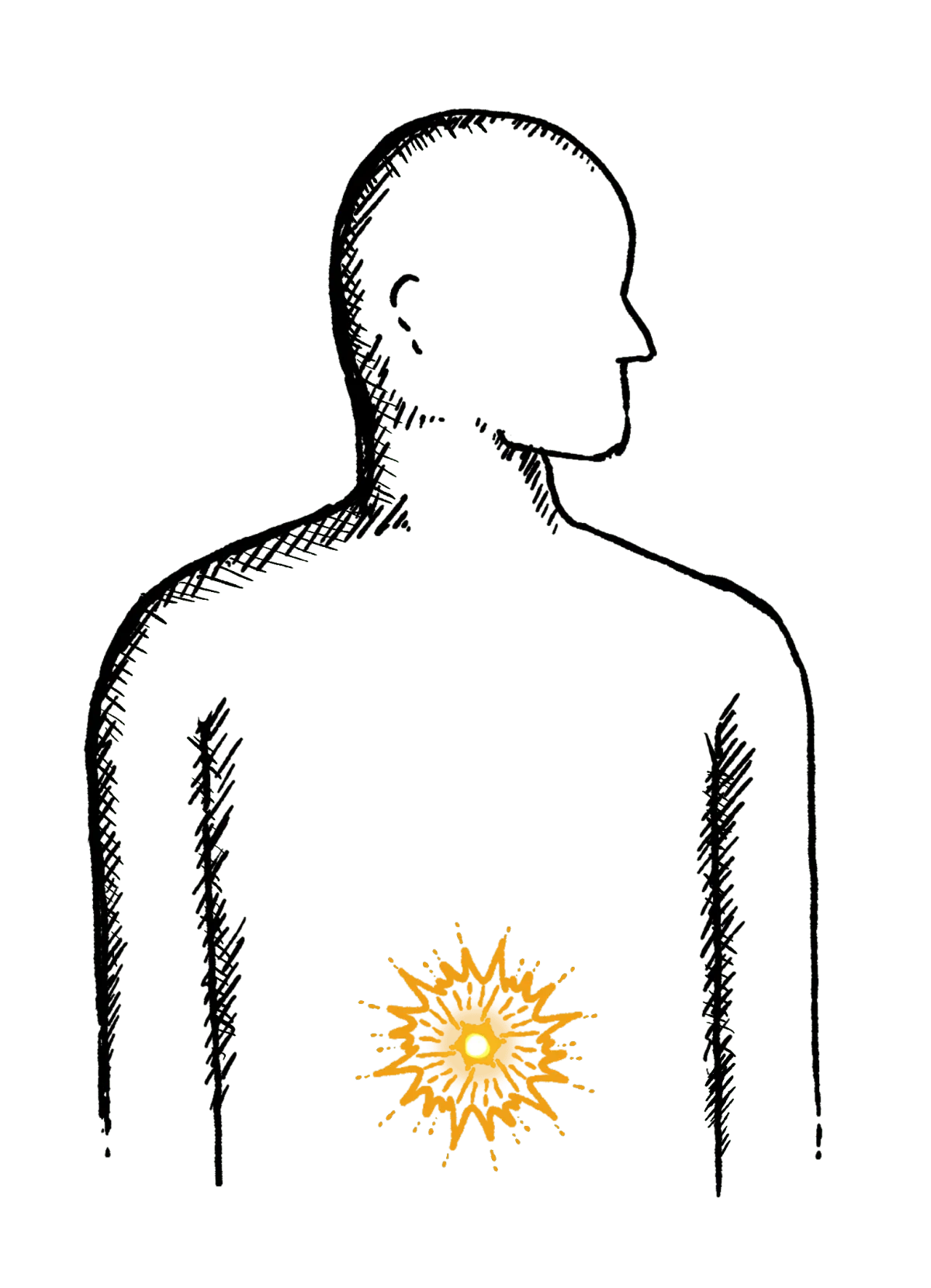
Difficulty going to the toilet, unusual stools, often with stomach ache or intestinal cramps, bloating, nausea or appetite loss
Bloating
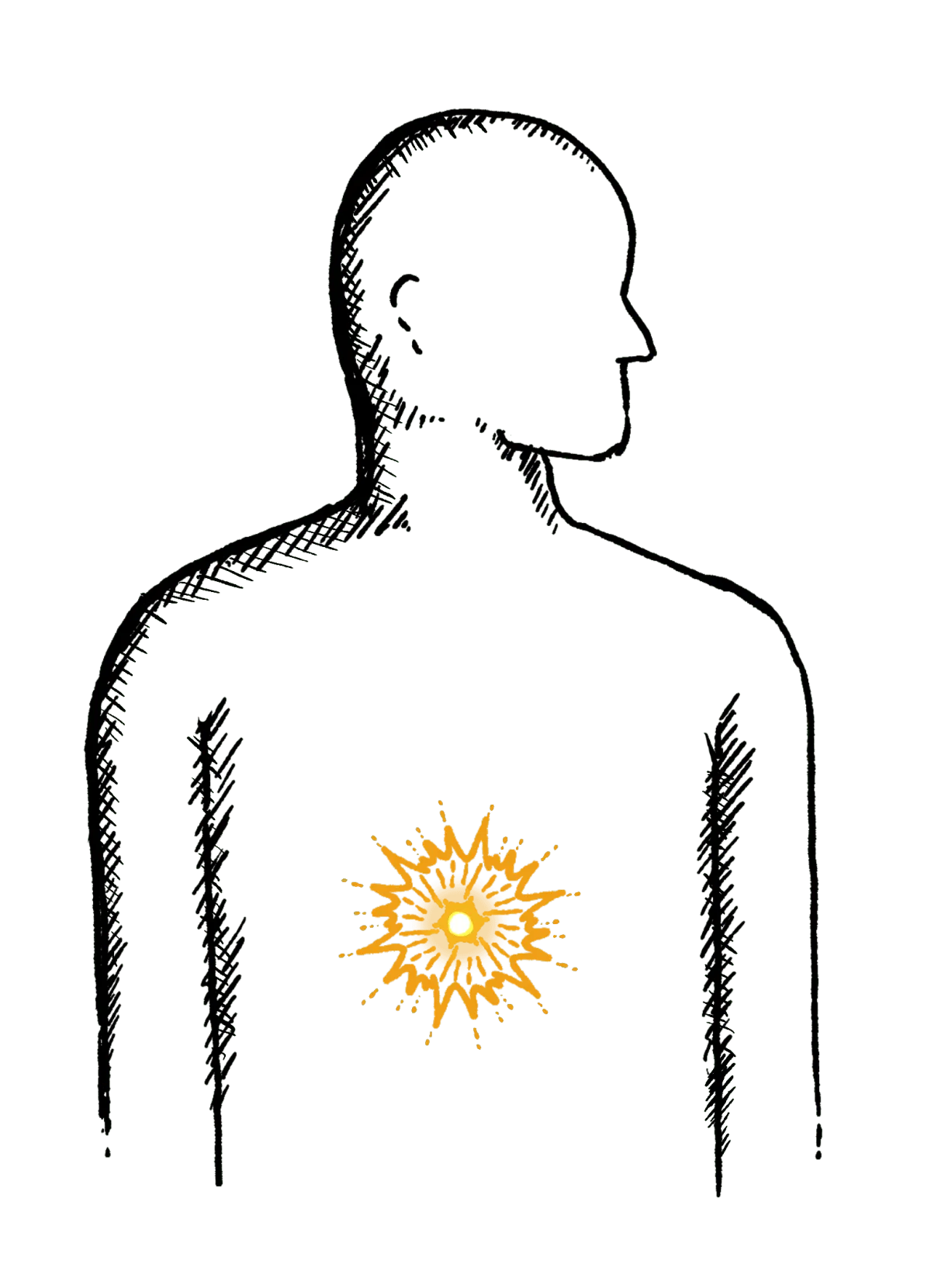
Feeling uncomfortably full and tight, excess belching/breaking wind, abdominal pain or gurgling
Regurgitation

Bringing food or drink back up, difficulty swallowing, feeling that food or drink is stuck in your throat, horrible taste in your mouth
Swallowing Issues
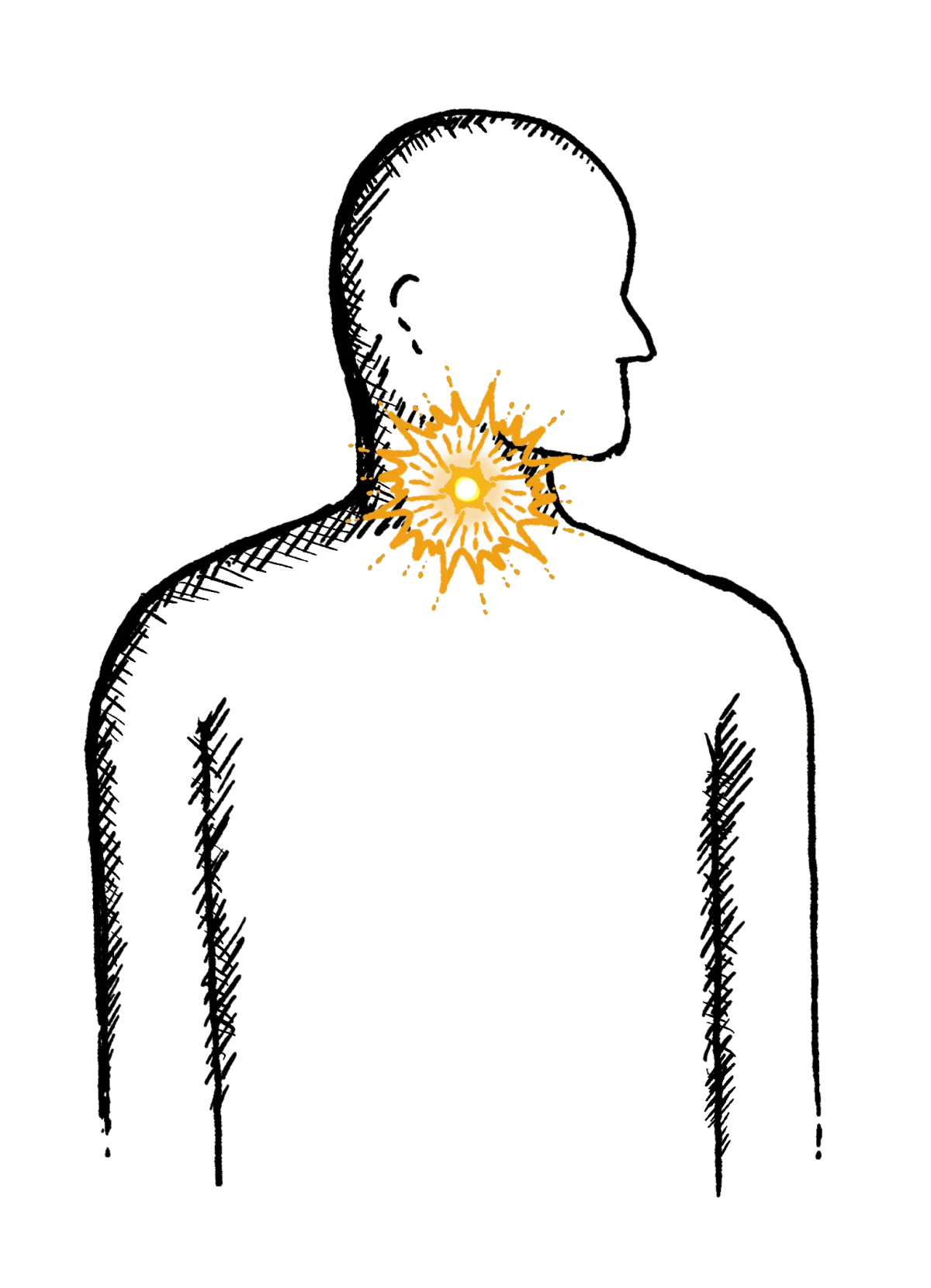
Dysphagia - difficulty swallowing, feeling that food or drink is stuck in your throat, horrible taste in your mouth
Diarrhoea
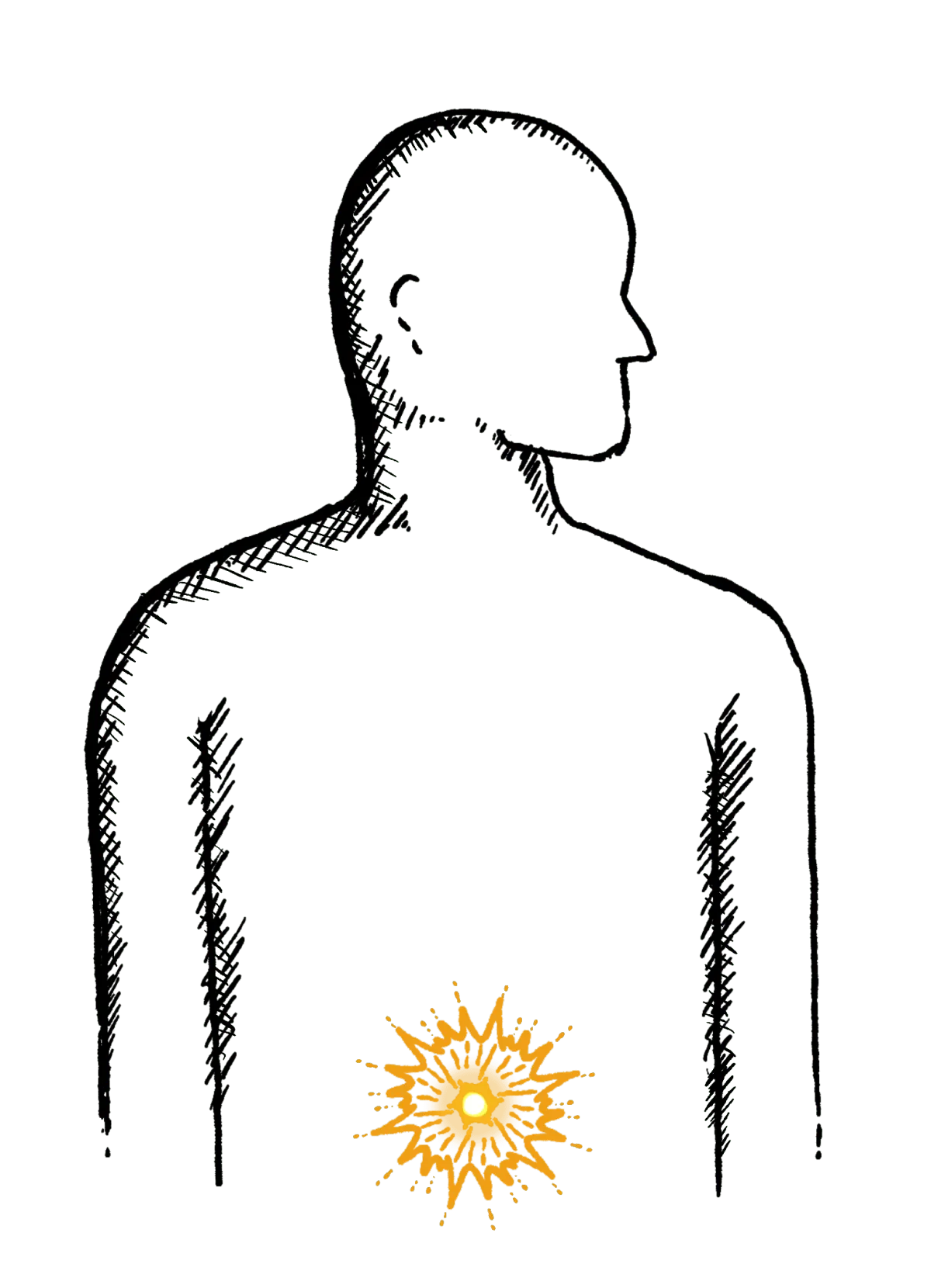
Loose or explosive stools, can’t get to a toilet in time
Abdominal Pain
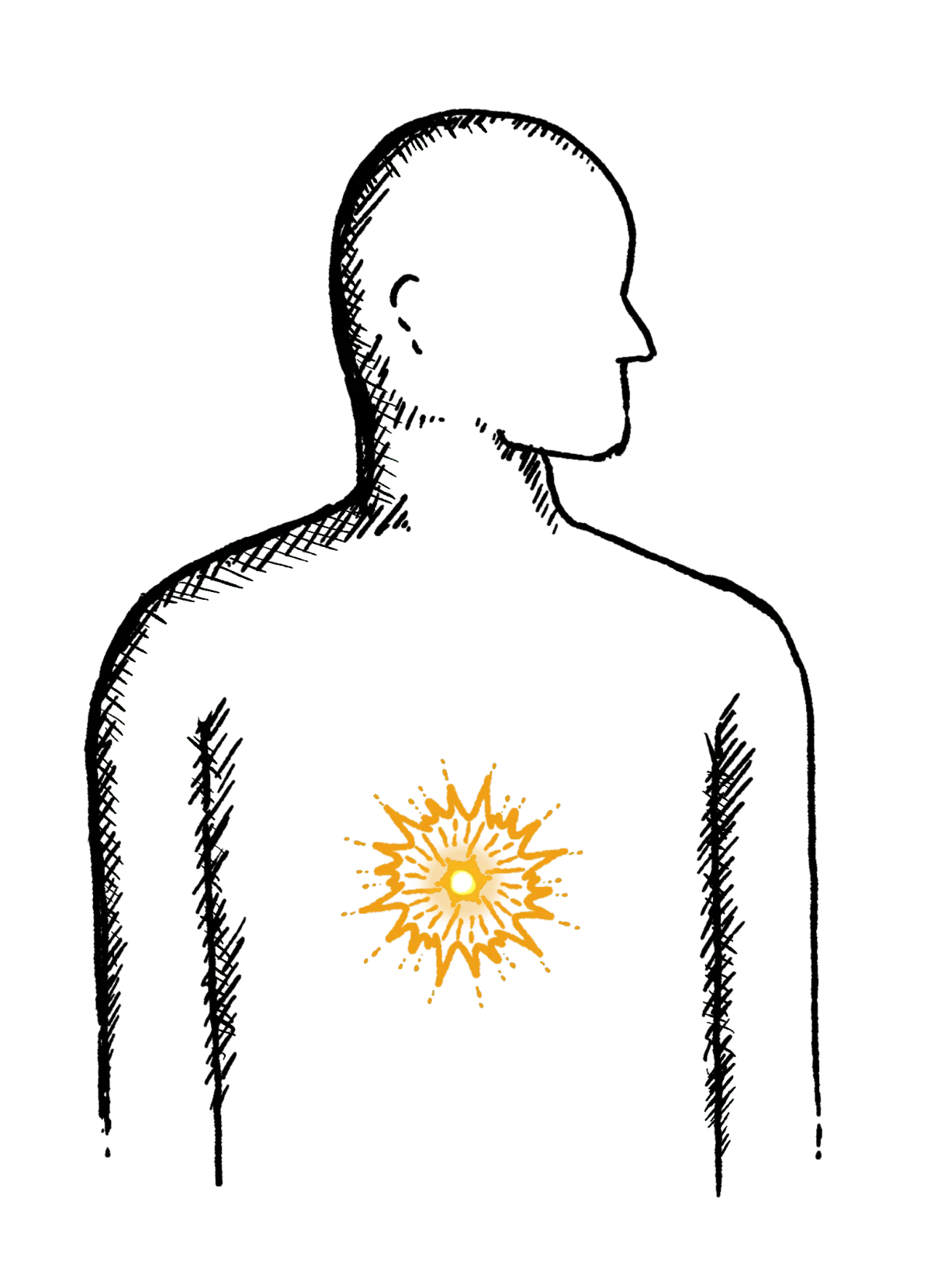
Cramps; sharp or dull pain, Bloating, Excessive belching, Nausea or vomiting
Faecal Incontinence

Stools leak unexpectedly, Can’t get to a toilet in time
IBS

Abdominal pain or cramping, bloating, changes in bowel habits and urgency, gas

